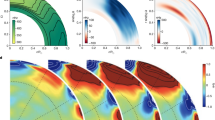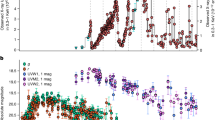Abstract
NOWHERE should the nonlinear features of general relativity show up more clearly than in the collisional interaction of two gravitational waves. One of the direct consequences of the linearity of Maxwell's equations is that electromagnetic waves pass straight through each other, and this is probably one of the best attested facts of physics. It may readily be demonstrated1 that such a principle of superposition can never apply to gravitational waves travelling in nonparallel directions, but the precise way in which the waves will diffuse through each other has not hitherto been understood. The problem may have a distinct bearing on observational phenomena, because the gravitational fluxes observed by Weber2 appear to be large enough to contribute significantly to the curvature of the universe3,4, hence large enough to make the linearized approximation invalid (a high frequency approximation has, however, been successfully applied to the cosmological problem by Isaacson5). We shall describe here a coordinate system in which the problem of colliding plane waves may be discussed in general relativity; a particular solution expressible in elementary functions and representing at least a portion of such a collisional situation will be given.
This is a preview of subscription content, access via your institution
Access options
Subscribe to this journal
Receive 51 print issues and online access
$199.00 per year
only $3.90 per issue
Buy this article
- Purchase on Springer Link
- Instant access to full article PDF
Prices may be subject to local taxes which are calculated during checkout
Similar content being viewed by others
References
Szekeres, P., J. Math. Phys., 6, 1387 (1965).
Weber, J., Phys. Rev. Lett., 22, 1320 (1969).
Sciama, D., Nature, 224, 1263 (1969).
Kafka, P., Nature, 226, 436 (1970).
Isaacson, R. A., Phys. Rev., 166, 1263, 1272 (1968).
Bondi, H., Pirani, F. A. E., and Robinson, I., Proc. Roy. Soc., A, 251, 519 (1959).
Lichnerowicz, A., Théories Relativistes de la Gravitation et de l'Electromagnétisme (Masson, Paris, 1955).
Penrose, R., in A.R.L. Tech. Documentary Rep. 63–56 (edit. by Bergmann, P. G.) (1963).
Szekeres, P. (in the press).
Newman, E., and Penrose, R., J. Math. Phys., 3, 902 (1962).
Penrose, R., Rev. Mod. Phys., 37, 215 (1965).
Author information
Authors and Affiliations
Rights and permissions
About this article
Cite this article
SZEKERES, P. Colliding Gravitational Waves. Nature 228, 1183–1184 (1970). https://doi.org/10.1038/2281183a0
Received:
Issue Date:
DOI: https://doi.org/10.1038/2281183a0
This article is cited by
-
Colliding plane gravitational waves of unequal strength
General Relativity and Gravitation (2023)
-
Gravity from symmetry: duality and impulsive waves
Journal of High Energy Physics (2022)
-
Cyclic spacetimes through singularity scattering maps. The laws of quiescent bounces
Journal of High Energy Physics (2022)
-
Refraction index analysis of light propagation in a colliding gravitational wave spacetime
General Relativity and Gravitation (2014)
-
A mechanism for obtaining a rapidly decreasing cosmological term at classical scales
General Relativity and Gravitation (2009)
Comments
By submitting a comment you agree to abide by our Terms and Community Guidelines. If you find something abusive or that does not comply with our terms or guidelines please flag it as inappropriate.



